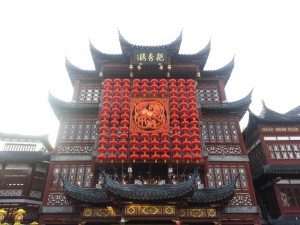Galloping toward a healthy China in the Year of the Horse: I Walk Hard for My Money
Xin Nian Kuaile! Happy Chinese New Year!
 As I sit here in my 19th-floor French Concession flat, still recovering from the shock and awe of the apocalyptic-like display of Lunar New Year fireworks I witnessed this week, I wonder what the year of the horse has in store for China.
As I sit here in my 19th-floor French Concession flat, still recovering from the shock and awe of the apocalyptic-like display of Lunar New Year fireworks I witnessed this week, I wonder what the year of the horse has in store for China.
According to Feng Shui practitioner, Raymond Lo: "The upcoming horse year is also a 'yang wood' year, when people will stick to their principles and stand firm. So it is hard to negotiate or compromise as there are more tendencies for people to fight for their ideals."
Granted, I’m no firm believer in the Chinese zodiac (or Western astrology for that matter) and my home is far from having good “feng shui,” but this prediction worries me. China is facing serious health threats in the year of the horse, and beyond. It is not the time to stick with the status quo.
As of 2013, 12% of China’s population had diabetes, making it not only the country with the highest number of people with the disease, but also the highest diabetes rate, surpassing that of the US and India. This epidemic has spread rapidly; in 1980, only 1% of China’s population had the disease. Worse, it’s poised to rise dramatically, with more than 50% of Chinese showing signs of pre-diabetes.
The diabetes epidemic is tied to expanding waistlines (over 11% of Chinese are obese and over 34% are overweight), which also increases the risk for other chronic diseases like heart disease, stroke, and cancer. While nutrition is certainly a significant factor in the spread of obesity, diabetes, and other non-communicable diseases, we know that sedentary behavior and lack of physical activity – tied partly to living and working in auto-oriented environments that lack walkability – is also to blame.
Now add unprecedented pollution levels to the mix. Just a couple of months ago, Shanghai experienced record-breaking pollution during the “airpocalypse,” with off the charts AQI levels, topping off somewhere just over 600 (the maximum was 500). The negative health consequences of air pollution are staggering: in 2010 alone, 1.2 million premature deaths were attributed to air pollution. In November, China reported the youngest on-record cancer patient – an 8-year-old girl from nearby Jiangsu province. While air pollution is caused by a variety factors, the swell in the number of automobiles (China lays claim to the world’s largest car market) – from just over 3200 in 1982 to over 100 million today – is indeed a contributor.
China’s seemingly insatiable appetite for cars along with the proliferation of cities better suited to four-wheeled inhabitants – other contributing factors not withstanding – will continue to exacerbate China’s mounting health issues. Facilitating walkability and more active transport is one way to lower the risk of chronic disease and combat pollution in China.
As part of my Fulbright work, I've sat down with several architects, planners and developers to discuss existing barriers to walkable development in China and potential solutions to overcome them. My discussions have been decidedly grim: the notion of overcoming the myriad political, cultural, and educational obstacles standing in the way of a more walkable, sustainable China has been met mostly with cynicism. (Stay tuned for future blog posts regarding this sadly, long list of challenges). The most hopeful response I’ve gotten thus far was more of a thinly veiled skeptical one: "Yes, China needs to change. They know they need to change. It will take a long time."
But China simply doesn’t have that "time." Urbanization is happening now. Over 54% of China’s population resides in cities; 60% will do so by 2018, two years ahead of schedule. By 2025, urban China – with its 350 million new residents – will be, for all intents and purposes “built out,” with the urbanization rate slowly stabilizing over the following two decades. This means new auto-centric cities – over 50 of them, each with 1+ million in population – are proliferating, now. Their mega-blocks are being planned and laid out, now. Their 10+ lane roads are being paved, now. Their towers in the park are being erected, now. The West has begun to accept that this type of vision for "tomorrow" was a misguided dystopian one; they are paying a hefty price to retrofit its byproduct into more human-scaled, sustainable places that people want and value. And yet China seems to be standing firm, determined to make these mistakes themselves, because, well, they can and they believe they have the right to so.
I certainly understand why China's knee-jerk reaction is to rebuff what can come across as pedantic Western "advice," but just as China doesn't have the luxury of time, it cannot afford (for its own sake) a "whatever, I do what I want" approach to urbanization. Once the urban fabric (block patterns, streets, building footprints, etc.) of new cities and suburban neighborhoods are laid out, it's dreadfully difficult to fix. Don’t get me wrong, strides have been made toward advancing sustainability. For example, China has acknowledged its pollution problem (admitting there’s a problem is the first step, right?); it’s even gone as far as to release data detailing the extent of its problem. But China has yet to do much about the fact (or realize) that the built environment – or the form that urbanization takes on – impacts individual, environmental, and even fiscal health and affects its State of Place moving forward.
My wish for China during this year of the horse is for it to mimic its moniker - to gallop its way toward change instead of holding firmly to its current stance. It must swiftly revise outdated auto-oriented, single-use zoning codes; expeditiously reconsider its land-lease as economic development strategy; forthwith begin to think long term; and feverishly work to establish interagency partnerships so that transportation, planning, and housing policies and practices all work in tandem toward curating a sustainable future. (More on these solutions in forthcoming blog posts!). In other words, China must change its approach to urbanization just as quickly as it has been urbanizing.
I hope that next year at this time, as we are celebrating the year of the sheep, that the horse has given the typically anxious sheep little to worry about, and that we can celebrate the many strides taken toward building a healthier China and improving its State of Place. Perhaps this is merely wishful thinking, but you could say the horse was one of the first sustainable forms of transport - when better to trek toward this type of change? I can say that as a horse myself, I’ll put all of my effort into seeing my research leads to a dynamic and productive horse year. First trot, a trip to Guizhou’s Center for Disease Control in two weeks to speak about walkability…

